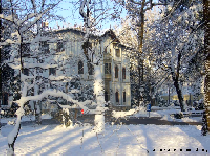Residences of the Stirbey Family
The Stirbey Family played a crucial role in the modernization of Romanian Principalities.

România Internațional, 21.02.2015, 09:01
The Stirbey Family, sharing the same bloodline with other leading ruling families in the Romanian Principalities, such as Bibescu, Brancoveanu and Cantacuzino, played its crucial role not only in the principalities’ modernization process, but also in Romania’s capital city. Ruling prince Barbu Stirbey was born into the Bibescu family but was adopted by the last descendant of the Stirbey family. He ruled Wallachia between June 1849 and October 1853, and a second time from October 1854 to June 1856. The principalities’ modernization process had already begun, as well as their opening towards Western Europe. Prince Barbu Stiebey had no objection to that, quite the contrary, he had his own contribution, to that effect. His descendants continued to get involved in Romania’s policy.
One of his most noteworthy descendants, who bore the prince’s name, Barbu Stirbey, was the president of the Council of Ministers, Minister of the Interior and an interim Finance and Foreign Affairs Minister. He was also an honorary member of the Romanian Academy between the wars, a close advisor to King Ferdinand and Queen Marie. Jointly with his father, Alexandru and his brothers and sisters, they owned several residences in Bucharest and abroad, which today are part of Romania’s cultural heritage. Furthermore, ruling prince Barbu Stirbey had a property in Nice, known as ‘The Orestis Mansion’ where he spent the last part of his life. In turn, his son, Prince George Stirbey, who was a diplomat, retired somewhere nearby Paris, in Courbevoie, where he had bought a palace of his own. Art historian Oana Marinache studied Stirbey family’s residencies in Romania. This helped her discover that many of the family’s properties were acquired when Barbu Stirbey married Elisabeta Cantacuzino. Oana Marinache:
”When Barbu married Elisabeta Cantacuzino Pascanu the assets of the family grew larger, thanks to a great number of properties that in the old days could be found among the property list of Constantin Brancoveanu’s family. So we can say that the ruling prince amassed a sizeable fortune, mainly made of land property. He had estates in Olt, Dolj, Vilcea, Mehedinti, in Romanati county (as it was known back then). In the second half of the 19th century, families had a different approach to family and marriage. For instance, prince Alexandru, who stayed in the country, married a member a boyars’ family from Moldavia. That’s how the Stirbey Family came into the Brusturoasa, Mandresti and Darmanesti estates, as well as large forest properties, with industrial exploitation. In Bucharest, there are a great many houses of the family as well, apart from the former Princely Palace, today’s Stirbey Palace on Victory Road, refurbished by price Alexandru”.
The former Princely Palace or the Stirbey Palace has survived to this day and can be seen on Victory Road, which is Bucharest’s oldest and most important avenue. Listen to Oana Marinache again, who this time will be providing us with a timeline for that building.
”It is an old boyar’s house, initially owned by the last of the Stirbeys, while in the early 19th century it was passed on to young steward Stirbey. Prior to becoming the ruling prince of Wallachia, he too commissioned a French architect, Michel de Sanjouand, who over 1833-1855 refurbished the old boyar’s house, upgrading it into a building everyone could envy. The residence is built in neo-classical style, which back then was in fashion. It would undergo major changes, but the most important of them is its enlargement over 1881 and 1882, operated by Friedrich Hartmann. He was a German architect who worked for the Stirbey family, and who, despite all the trending styles at the time, stuck to the initial construction and enlarged the building, also adding a tower. It was also him who built the stables that sadly were brought down by the present owner in late 2008.“
In the early 20th century, the Stirbey family started collaborating with architect Nicolae Ghika Budesti on a number of private projects, restoration works and the building of new residences. Here is Oana Marinache again:
“On Grivita Road, close to the Royal Palace on Victory Road, there was a palace owned by prince George, prince Barbu’s younger brother, who died tragically in WWI. The palace used to be emblematic for the centre of the city, since 1911 until WWII. The ruler’s nieces too built their own mansions nearby, resorting to the same architect, Nicolae Ghika Budesti. These houses are still there, near Victory Road. We believe that the Palace on Grivita Road was bombed, but we do have the plans and photos of the palace. Many of the residencies outside the city were turned into either hospitals, as it happened with the mansion in Voila, near Campina, which still is a psychiatric hospital, or into something else. In Darmanesti authorities set up a children’s summer camp. Then the palace was left to decay, then reclaimed by the daughters of the Stirbey princesses.”
Another famous family residence is the one located in Buftea, near Bucharest. The estate is dominated by the palace built in the Romantic style, although the architect is unknown.






























